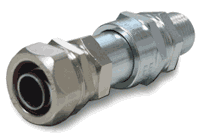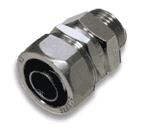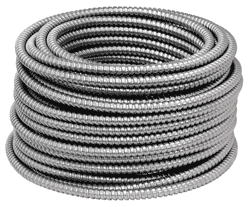KOVTVL explosion-proof cable glands for armored cable in hoses, pipe conduits, metal hoses, as well as open wiring or cables laid in cable tray, are used in places where explosion-proof sealing on cable sheath is required. They secure the cable against accidental pulling out. KOVTVL explosion-proof cable glands feature inner thread at the outlet, which helps to connect flexible hoses, pipe conduits, corrugated metal hoses, etc. It is allowed to use KOVTVL cable glands for non-armored cables.
The most important development is the use of one sealing ring for the whole range of diameters of crimped cable, which reliably crimps the incoming cable and ensures Exd type of protection. One sealing ring together with mandrel or cable withstand the force in newtons, which is equal to the twentyfold diameter value (in mm) of the mandrel or the cable. This helps to use KOVTVL series explosion-proof cable glands without additional unloading of cable.
Increased wall thickness of bodies of GORELTEX cable glands considerably enhances their strength compared with cable glands of other manufacturers.
Clamping ring of the armor helps to use KOVTVL cable gland for all types of cable armor/braid: wire armor, with braid, tape armor. Clamping ring of the armor helps to crimp armor/braid with the thickness from 0 to 2.5 mm.
The main difference between KOVTVL series cable glands from KOVTV series is absence of external sealing ring for armor IP. Also, as in KOVTV cable glands one sealing ring is used to fasten the cable (in cable glands with dimension types from 1 to 4). Two sealing rings are used in KOVTVL cable glands of 5 and 6 dimension types in order to increase the range of crimped cable.
Combined single orientation clamping system of the armor and sealing of cable inner sheath are used in KOVTVL series cable glands. Such combined system helps to avoid phase-to-phase voltage/ linear shift between inner sheath and armor/braid of the cable during mounting of cable gland. Mounting of KOVTVL series cable gland is more convenient and error-free: presence of a combined fastening element does not require constant balancing between fastening clamp of the armor and that of the cable inner sheath. This guarantees high-quality sealing of the cable inner sheath and reliable galvanic coupling between cable gland body and cable armor. Dimensions of cable glands are significantly reduced which helps to save space and reduce the weight of the explosion-proof device.
KOVTVL explosion-proof cable glands ensure earthing circuit continuity between cable armor/braid and cable gland body by means of clamping ring of the armor/braid that ensures protection against electromagnetic disturbances.
KOVTVL cable glands may be used for direct insertion as a part of fireproof enclosures of IIA, IIB+H2, IIC subgroups, which have the volume exceeding 2000 cm3.
KOVTVL explosion-proof cable glands are completely suitable for use with equipment having ExnR marking.
Thanks to their design, KOVTVL explosion-proof cable glands ensure cable unloading, protection against pulling out without causing damage to the structure of cable sheath and conductors, as well as prevent cable overcompression.
When choosing KOVTVL series cable gland, it is necessary to consider that dimension type of thread at the outlet is larger than at the connecting part.
Explosion-proof cable glands of KOVTVL series are designed in Russia (Patent No. 155936, rightholder "ZAVOD GORELTEX" Co. Ltd. , operating characteristics of which significantly surpass Russian and foreign analogues.
Scope of application – outdoor and indoor hazardous areas as per explosion protection marking, GOST 30852.13-2002 (IEC 60079-14:1996), dangerous production facilities of I, II, III, IV hazard class supervised by Rostechnadzor of the RF and national technical supervision bodies of the Customs Union and CIS countries.
 1Ex db IIC Gb
1Ex db IIC Gb 1Ex e IIС Gb
1Ex e IIС Gb 2Ex nR IIС Gc
2Ex nR IIС Gc Ex tb IIIC Db
Ex tb IIIC Db
| Cable gland dimension type | Thread | Dimensions, mm | Diameter of crimped cable, mm | Mass, kg | all files |
||||||
| M1, |
M2, |
АС1 | АС2 | АС3 | ØM | C | Inner Ød | Outer ØD | |||
| KOVTVL1MG | M20x1,5 | 1/2" | 30 | 30 | 24 | 33 | 85 | 5-14 | 8-18 | 0,2 | |
| KOVTVL2MG | M25x1,5 | 3/4" | 34 | 34 | 30 | 37 | 93 | 9-18 | 12-23 | 0,3 | |
| KOVTVL2MG.../Р | M25x1,5 | 3/4" | 34 | 34 | 30 | 37 | 93 | 4-18 | 12-23 | 0,3 | |
| KOVTVL3MG | M32x1,5 | 1" | 41 | 41 | 36 | 46 | 97 | 14-23 | 17-29 | 0,4 | |
| KOVTVL3MG.../Р | M32x1,5 | 1" | 41 | 41 | 36 | 46 | 97 | 8-23 | 17-29 | 0,4 | |
| KOVTVL4MG | M40x1,5 | 1 1/4" | 50 | 50 | 46 | 56 | 91 | 22-31 | 25-37 | 0,5 | |
| KOVTVL4MG.../Р | M40x1,5 | 1 1/4" | 50 | 50 | 46 | 56 | 91 | 17-31 | 25-37 | 0,5 | |
| KOVTVL5MG | M50x1,5 | 1 1/2" | 60 | 60 | 55 | 65 | 89 | 31-41 | 34-44 | 0,7 | |
| KOVTVL5MG.../Р | M50x1,5 | 1 1/2" | 60 | 60 | 55 | 65 | 89 | 21-41 | 24-44 | 0,7 | |
| KOVTVL6MG | M63x1,5 | 2" | 70 | 70 | 70 | 78 | 95 | 39-49 | 42-55 | 1 | |
| KOVTVL6MG.../Р | M63x1,5 | 2" | 70 | 70 | 70 | 78 | 95 | 29-49 | 32-55 | 1 | |
| Cable gland dimension type | Thread | Dimensions, mm | Diameter of crimped cable, mm | Mass, kg | ||||||
| M1, NPT | M2, |
АС1 | АС2 | АС3 | ØM | C | Inner Ød | Outer ØD | ||
| KOVTVL1NG | 1/2" | 1/2" | 30 | 30 | 24 | 33 | 88 | 5-14 | 8-18 | 0,2 |
| KOVTVL2NG | 3/4" | 3/4" | 34 | 34 | 30 | 37 | 96 | 9-18 | 12-23 | 0,3 |
| KOVTVL2NG.../Р | 3/4" | 3/4" | 34 | 34 | 30 | 37 | 96 | 4-18 | 12-23 | 0,3 |
| KOVTVL3NG | 1" | 1" | 41 | 41 | 36 | 46 | 104 | 14-23 | 17-29 | 0,4 |
| KOVTVL3NG.../Р | 1" | 1" | 41 | 41 | 36 | 46 | 104 | 8-23 | 17-29 | 0,4 |
| KOVTVL4NG | 1 1/4" | 1 1/4" | 50 | 50 | 46 | 56 | 98 | 22-31 | 25-37 | 0,5 |
| KOVTVL4NG.../Р | 1 1/4" | 1 1/4" | 50 | 50 | 46 | 56 | 98 | 17-31 | 25-37 | 0,5 |
| KOVTVL5NG | 1 1/2" | 1 1/2" | 60 | 60 | 55 | 65 | 97 | 31-41 | 34-44 | 0,7 |
| KOVTVL5NG.../Р | 1 1/2" | 1 1/2" | 60 | 60 | 55 | 65 | 97 | 21-41 | 24-44 | 0,7 |
| KOVTVL6NG | 2" | 2" | 70 | 70 | 70 | 78 | 95 | 39-49 | 42-55 | 1 |
| KOVTVL6NG.../Р | 2" | 2" | 70 | 70 | 70 | 78 | 95 | 29-49 | 32-55 | 1 |
| RKN type | Name of metal hose | Inside diameter of metal hose, mm | Diameter of KOVTVL external connection thread, G cylindrical pipe thread GOST 6357-81 |
| RKN12 | RZ-TSKH-12, MRPI-12 | 12 | 1/2" |
| RKN15 | RZ-TSKH-15, MRPI-15 | 15 | 1/2" |
| RKN16НК | ГЕРДА-МГ-16 | 16 | 1/2" |
| RKN20+AB-2GВ-1GН | RZ-TSKH-20, MRPI-20 | 20 | 1/2" |
| RKN20 | RZ-TSKH-20, MRPI-20 | 20 | 3/4" |
| RKN22НК | ГЕРДА-МГ-22 | 22 | 3/4" |
| RKN25+AB-3GВ-2GН | RZ-TSKH-25, MRPI-25 | 25 | 3/4" |
| RKN25 | RZ-TSKH-25, MRPI-25 | 25 | 1" |
| RKN25НК | ГЕРДА-МГ-25 | 25 | 1" |
| RKN32+AB-4GВ-3GН | RZ-TSKH-32, MRPI-32 | 32 | 1" |
| RKN32 | RZ-TSKH-32, MRPI-32 | 32 | 1 1/4" |
| RKN35НК | ГЕРДА-МГ-35 | 35 | 1 1/4" |
| RKN38+AB-5GВ-4GН | RZ-TSKH-38, MRPI-38 | 38 | 1 1/4" |
| RKN38 | RZ-TSKH-38, MRPI-38 | 38 | 1 1/2" |
| RKN40НК | ГЕРДА-МГ-40 | 40 | 1 1/2" |
| RKN50+AB-6GВ-5GН | RZ-TSKH-50, MRPI-50 | 50 | 1 1/2" |
| RKN50 | RZ-TSKH-50, MRPI-50 | 50 | 2" |
* In order to connect the metal hoses with different combination of inside diameter and diameter of crimped cable, it is required to use other size of AV adapter.





| KOVTVL | X | Х | Х | Х | Х | / | Х | – TU 3400-007-72453807-07 |
| Cable gland type | ||||||||
| Dimension type | ||||||||
| Thread type: Taper inch NPT - N; Metric GOST 24705 - M;
Taper pipe GOST 6211-81 - R; Pipe cylindrical GOST 6357-81 - G |
||||||||
| Dimension type for external connection* | ||||||||
| Type of thread for external connection thread**: Taper inch NPT - N; Metric GOST 24705 - M; Taper pipe GOST 6211-81 - R; Pipe cylindrical GOST 6357-81 - G |
||||||||
| Cable gland material: Nickel-plated brass - NK, Stainless steel - N | ||||||||
| Options, accessories and versions |